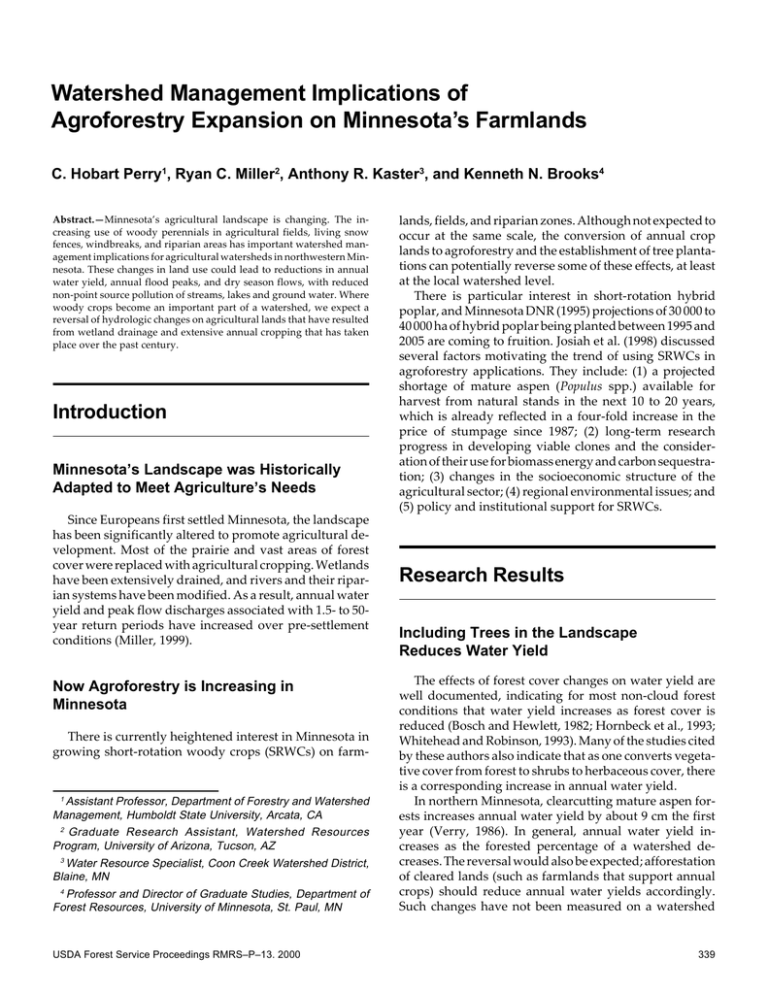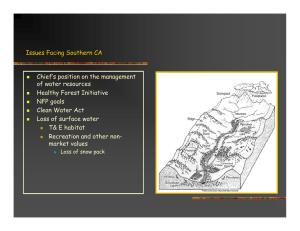Watershed Management Implications of Agroforestry Expansion on Minnesota’s Farmlands C. Hobart Perry
advertisement

Watershed Management Implications of Agroforestry Expansion on Minnesota’s Farmlands C. Hobart Perry1, Ryan C. Miller2, Anthony R. Kaster3, and Kenneth N. Brooks4 Abstract.—Minnesota’s agricultural landscape is changing. The increasing use of woody perennials in agricultural fields, living snow fences, windbreaks, and riparian areas has important watershed management implications for agricultural watersheds in northwestern Minnesota. These changes in land use could lead to reductions in annual water yield, annual flood peaks, and dry season flows, with reduced non-point source pollution of streams, lakes and ground water. Where woody crops become an important part of a watershed, we expect a reversal of hydrologic changes on agricultural lands that have resulted from wetland drainage and extensive annual cropping that has taken place over the past century. Introduction Minnesota’s Landscape was Historically Adapted to Meet Agriculture’s Needs Since Europeans first settled Minnesota, the landscape has been significantly altered to promote agricultural development. Most of the prairie and vast areas of forest cover were replaced with agricultural cropping. Wetlands have been extensively drained, and rivers and their riparian systems have been modified. As a result, annual water yield and peak flow discharges associated with 1.5- to 50year return periods have increased over pre-settlement conditions (Miller, 1999). Now Agroforestry is Increasing in Minnesota There is currently heightened interest in Minnesota in growing short-rotation woody crops (SRWCs) on farm- 1 Assistant Professor, Department of Forestry and Watershed Management, Humboldt State University, Arcata, CA 2 Graduate Research Assistant, Watershed Resources Program, University of Arizona, Tucson, AZ 3 Water Resource Specialist, Coon Creek Watershed District, Blaine, MN 4 Professor and Director of Graduate Studies, Department of Forest Resources, University of Minnesota, St. Paul, MN USDA Forest Service Proceedings RMRS–P–13. 2000 lands, fields, and riparian zones. Although not expected to occur at the same scale, the conversion of annual crop lands to agroforestry and the establishment of tree plantations can potentially reverse some of these effects, at least at the local watershed level. There is particular interest in short-rotation hybrid poplar, and Minnesota DNR (1995) projections of 30 000 to 40 000 ha of hybrid poplar being planted between 1995 and 2005 are coming to fruition. Josiah et al. (1998) discussed several factors motivating the trend of using SRWCs in agroforestry applications. They include: (1) a projected shortage of mature aspen (Populus spp.) available for harvest from natural stands in the next 10 to 20 years, which is already reflected in a four-fold increase in the price of stumpage since 1987; (2) long-term research progress in developing viable clones and the consideration of their use for biomass energy and carbon sequestration; (3) changes in the socioeconomic structure of the agricultural sector; (4) regional environmental issues; and (5) policy and institutional support for SRWCs. Research Results Including Trees in the Landscape Reduces Water Yield The effects of forest cover changes on water yield are well documented, indicating for most non-cloud forest conditions that water yield increases as forest cover is reduced (Bosch and Hewlett, 1982; Hornbeck et al., 1993; Whitehead and Robinson, 1993). Many of the studies cited by these authors also indicate that as one converts vegetative cover from forest to shrubs to herbaceous cover, there is a corresponding increase in annual water yield. In northern Minnesota, clearcutting mature aspen forests increases annual water yield by about 9 cm the first year (Verry, 1986). In general, annual water yield increases as the forested percentage of a watershed decreases. The reversal would also be expected; afforestation of cleared lands (such as farmlands that support annual crops) should reduce annual water yields accordingly. Such changes have not been measured on a watershed 339 basis in Minnesota, however, there is sufficient research to suggest that these same changes would occur. Recent studies of hybrid poplar plantations in northwestern Minnesota indicate that they have consumptive use characteristics similar to those of natural aspen stands. These results imply that any significant increase in tree cover on a watershed that was previously under an open, cultivated condition should reduce water yield. The volume and timing of water yield of mature natural aspen stands and short-rotation hybrid poplar plantations are functionally identical (Perry et al., 1999). Land use conversion and total annual rainfall have interacting effects on annual water yield. A modeling study of the Pomme de Terre watershed of west-central Minnesota demonstrated that the conversion of cropland to hybrid poplar results in a 43% (3.0 cm) reduction in water yield during periods of average precipitation (Kaster, 1999). During periods of greater than average precipitation, the influence of agroforestry on annual water yield is much less. Using climatic extremes recorded during 1993, a conversion of agriculture to agroforestry with SRWCs reduced water yield by only 3% (0.6 cm) (Kaster, 1999). depth and type of soil frost in contrast to open fields (discussed by Baker (1972)). Soil frost is deeper, and concrete frost is more prevalent in cultivated fields than in hardwood forests. Snowpacks tend to be deeper in forest stands as they are not subjected to wind, but the snowpack melts at a slower rate and spreads out the period over which snowmelt runoff occurs. Snowmelt runoff under forest cover is, therefore, less efficient than snowmelt runoff from open, cultivated fields. On a watershed basis, the magnitude of annual peak flow discharges from snowmelt runoff was found to be related to the percentage of the watershed that is forested vs. cleared or open (fig. 1) (Verry et al., 1983). As illustrated, increasing forest cover from 0 to about 40 to 50% on a watershed can significantly reduce snowmelt peakflow discharge as a result of desynchronization of snowmelt runoff. With the recent observation that hybrid poplar plantations have hydrologic characteristics similar to those of natural aspen stands in northern Minnesota (Perry et al., Including Trees in the Landscape Reduces Peakflow Discharge The hydrologic effects of increasing the acreage of hybrid poplar on the agricultural landscape have not been extensively studied in northwestern Minnesota. However, research in north central Minnesota indicated that clearcutting natural aspen stands can lead to a doubling of both average annual snowmelt peak discharges and rainfall storm flow peak discharges (Verry et al., 1983). These responses are within the same order of magnitude as changes in peak flow resulting from wetland drainage and conversion from prairie vegetation to annual cropping (Miller, 1999). In the case of rainfall, peakflows tend to increase as the percentage of forest that is clearcut increases. Therefore, increasing forest cover on the watershed should have the opposite effect. Furthermore, increasing tree cover along riparian zones and in floodplains has the added effects of streambank and channel stabilization (Rosgen, 1994). The potential effects of converting annual crops to hybrid poplar on snowmelt runoff are numerous. In contrast to open fields, forest cover influence can alter snowmelt runoff response through changes in antecedent soil moisture conditions, soil frost, snow depositional patterns, and melt rates. Given the above discussion on water yield and evapotranspiration, one would expect soil moisture conditions on average to be drier entering the fall, than soils that have supported annual crops. Weitzman and Bay (1963) indicated that forest cover reduces the 340 Figure 1. Relation between the portion of a watershed clearcut (with regrowth for at least nine years) and the change in snowmelt peak discharge compared to mature aspen forest conditions. Circles are measured; lines hypothesize an envelope of response for northern Lake State conditions. (From Verry et al., 1983) USDA Forest Service Proceedings RMRS–P–13. 2000 1999), any significant increase in tree cover on a watershed that was previously under an open, cultivated condition should reduce peak flows from either rainfall or snowmelt. Including Trees in the Landscape Improves Water Quality Short-rotation woody crops have the potential to improve regional water quality when they replace annual agricultural crops. When measured over the course of a complete rotation, pesticide inputs to SRWCs are substantially less than the agricultural crops they replace. SRWCs will require approximately 11% of the herbicides applied to corn and 20% of those applied to soybeans (Ranney and Mann, 1994). Mature short rotation hybrid poplar also contributes much less total nitrogen to ground water than the agricultural crops they replace: 2.3 kg N ha-1 yr-1 versus 36.5 kg N ha-1 yr-1 (Lowrance, 1992; Perry, 1998). Water migrating through the unsaturated soil under riparian buffers that include SRWCs loses most of the associated NO3-N at the field border beneath the strip, reducing nutrient loading to adjacent water bodies (Schultz et al., 1995). However, while water quality benefits of energy crop production are expected to be largely positive, some results suggest that recommended US Environmental Protection Agency (EPA) nitrate limits could be exceeded 1 or 2 years out of 20 in some locations (Ranney and Mann, 1994). Given the expected growth in forested acreage in northwestern Minnesota, nutrient loading to adjacent stream bodies and shallow ground water should be reduced. Conclusions Given the economic and environmental conditions in northwestern Minnesota, large acreages of farmland will likely be converted from annual cropping to short-rotation tree plantations. In terms of the effects of such land use changes on the Red River of the North, it is unlikely that a large percentage of the river basin would be converted to SRWCs. The eastern tributary watersheds along the prairie-forest border however could experience large increases in the percentage of watershed that is tree-covered. It is possible that such changes in plant cover could decrease antecedent soil moisture conditions in local watersheds; tree crops consume more water than annual crops (Lee, 1980). In addition to the expected reductions in annual average peak flows in streams (Verry et al., 1983), the reduction in soil moisture could also reduce the area of USDA Forest Service Proceedings RMRS–P–13. 2000 saturated soils contributing to stormflow during average events (Hewlett and Troendle, 1975). Flood flows in the level topography of the Red River of the North are dramatically affected by the areal extent of saturated soil. The results of our studies, when combined with earlier forest hydrology - watershed studies in north central Minnesota, suggest that the conversion from non-forested, annual croplands to agroforestry with short-rotation hybrid poplar crops could reduce both the annual water yield and the magnitude of annual peakflow discharges from rainfall and snowmelt events. The economic conditions in the region are currently favorable for large acreages of marginal farmland to be planted with shortrotation hybrid poplar. If such is the case, and large percentages of tributary watersheds of the Red River of the North are so converted, there is the possibility that the magnitude of annual floods in these tributary streams could be reduced. Acknowledgments We would like to acknowledge technical reviews by Dr. Jack Cheng of the National Chung-Hsing University, Taichung, Taiwan, and Dr. Sandy Verry of the USDA Forest Service North Central Research Station, Grand Rapids, Minnesota, USA. Literature Cited Baker, D.G. 1972. Prediction of spring runoff. Water Resources Research 8: 966-972. Bosch, J.M. and J.D. Hewlett. 1982. A review of catchment experiments to determine the effect of vegetation changes on water yield and evapotranspiration. Journal of Hydrology 55: 3-23. Hewlett, J.D. and C.A. Troendle. 1975. Nonpoint and diffused water sources: A variable source area problem. In Proceedings of a Symposium on Watershed Management, Utah State University, 21-46. New York: American Society of Civil Engineers. Hornbeck, J.W., M.B. Adams, E.S. Corbett, E.S. Verry and J.A. Lynch. 1993. Long-term impacts of forest treatments on water yield: A summary for northeastern USA. Journal of Hydrology 150: 323-344. Josiah, S.J., H.M. Gregersen, E. Streed, C.H. Perry and K.N. Brooks. 1998. The potential for integrating short-rotation woody crops into agroforestry systems and practices in the United States: A national assessment. St. 341 Paul, MN: Center for Integrated Natural Resources and Agricultural Management, University of Minnesota. Kaster, A.R. 1999. Predicting the effect of hybrid poplar trees on a water budget: Pomme de Terre watershed, Minnesota. M.S. thesis, University of Minnesota. Lee, R. 1980. Forest Hydrology. New York: Columbia University Press. Lowrance, R.R. 1992. Nitrogen outputs from a field-sized agricultural watershed. Journal of Environmental Quality 21: 602-607. Miller, R.C. 1999. Hydrologic effects of wetland drainage and land use change in a tributary watershed of the Minnesota River Basin: A modelling approach. M.S. thesis, University of Minnesota. Minnesota Department of Natural Resources. 1995. Short Rotation Woody Culture: Analysis of a 10,000 Acres per Year Hybrid Poplar Planting Program. St. Paul, MN: Division of Forestry. Perry, C.H. 1998. Hydrologic impacts of short-rotation woody crop production in northwestern Minnesota. Ph.D. thesis, University of Minnesota. Perry, C.H., R.C. Miller and K.N. Brooks. 1999. Impacts of short-rotation woody crops on regional water yield. Forest Ecology and Management (Special Issue) - The 342 Science of Managing Forests to Sustain Water Resources: An International Conference. In press. Ranney, J.W. and L.K. Mann. 1994. Environmental considerations in energy crop production. Biomass and Bioenergy 6: 211-228. Rosgen, D.L. 1994. A classification of natural rivers. Catena 22: 169-199. Schultz, R.C., J.P. Colletti, T.M. Isenhart, W.W. Simpkins, C.W. Mize and M.L. Thompson. 1995. Design and placement of a multi-species riparian buffer strip system. Agroforestry Systems 29: 201-226. Verry, E.S. 1986. Forest harvesting and water: The Lake States experience. Water Resources Bulletin 22: 1039-1047. Verry, E.S., J.R. Lewis and K.N. Brooks. 1983. Aspen clearcutting increases snowmelt and storm flow peaks in north central Minnesota. Water Resources Bulletin 19: 59-67. Weitzman, S. and R.R. Bay. 1963. Forest soil freezing and the influence of management practices, northern Minnesota. Research Paper LS-2. St. Paul, MN: USDA Forest Service. Whitehead, P.G. and M. Robinson. 1993. Experimental basin studies: An international and historical perspective of forest impacts. Journal of Hydrology 145: 217-230. USDA Forest Service Proceedings RMRS–P–13. 2000




